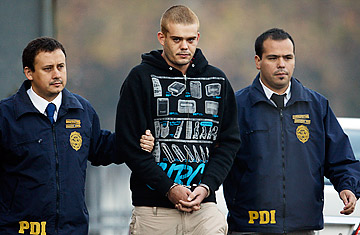
Authorities escort Joran van der Sloot in Santiago, Chile, on June 4, 2010
Might Joran van der Sloot's confession be the Dutchman's key to getting a more lenient sentence from Peru's justice system?
According to police investigators in Lima, van der Sloot, 22, said he met Stephany Flores Ramirez, 21, at a casino and ended up with her in a room he was renting in a low-budget hotel in Miraflores, one of Lima's swankier neighborhoods. After the two awoke early on May 30, van der Sloot said, he went out to get coffee and rolls. When he returned, he said, Flores was using his laptop. Van der Sloot, according to police sources, said Flores had pulled up information relating to his alleged involvement in the case of Natalee Holloway, a young American who went missing in Aruba in 2005. Van der Sloot, who had been the prime suspect in the Holloway case, said Flores' snooping sent him into a rage. "It was an invasion of my privacy. She had no right," he allegedly told the investigating officers. He said they fought and he beat her repeatedly, breaking her neck.
Rage is a key element in the confession that could conceivably get van der Sloot a lighter sentence. "The confession is part of a strategy to show that the murder was not premeditated to keep the sentence to a minimum," says Luis Lamas Puccio, a well-known criminal lawyer in Lima. Indeed, detectives are furious that van der Sloot's court-appointed lawyer, Rosa Camargo, has "manipulated the case and planted the idea of a crime of passion," in the words of one detective.
In Peru, a crime of passion could lead to a sentence as low as seven years, which could mean that van der Sloot walks in three or four years. Otherwise, if van der Sloot is found guilty of premeditated, first-degree murder, he could spend between 15 and 35 years in prison. (There is no death penalty in Peru.) There has also been talk about the possibility of leveling a charge of aggravated robbery against him, which is punishable with a life sentence. There are reports that Flores won about $1,000 playing poker the night she met van der Sloot. No money was found at the crime scene.
Police are now trying to get van der Sloot to help them reconstruct the crime, taking him to the Atlantic City Casino, where he met Flores, and then to the Hotel Tac, where she was killed in Room 309. Such re-enactments, commonplace in Peruvian investigations, are staged to help officers find flaws in confessions that might lead to more clues and evidence. At the very least, police say, the fact that van der Sloot showered and changed before leaving the hotel and Flores' body and that he fled to Chile will work against his "rage" defense. They are also actively pursuing the possibility that it was no coincidence that the Flores murder fell on the fifth anniversary of the disappearance of Holloway.
The van der Sloot case has taken on new life in the U.S., where Holloway's disappearance has received massive coverage over the past five years. On the day of van der Sloot's arrest in Chile, the U.S. Attorney for the Northern District of Alabama charged him with fraud based on allegations that the young Dutchman had offered information on the Holloway case in exchange for $250,000. And, in a new twist, the Associated Press reported on Thursday that the FBI may have provided $25,000 to a third party as part of sting to nab van der Sloot on the fraud charges. Van der Sloot allegedly received at least $15,000, which seems to have funded his South American gambling trip, first to Colombia and then to Peru. According to the AP, however, the FBI delayed arresting the Dutchman because it was trying to build a murder case against him in the Holloway disappearance. During the delay, Flores was murdered.
